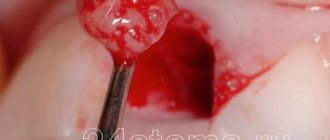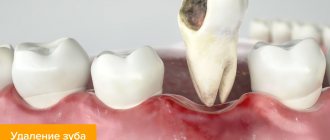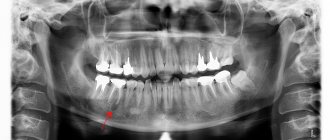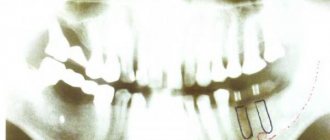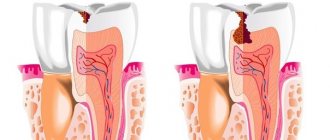According to antiplagiat.ru, the uniqueness of the text as of October 16, 2018 is 90.3%.
Key words, tags: tooth extraction, wisdom tooth, bone tissue, implant installation, augmentation, implantation.
Despite the rapid development of modern dentistry, tooth extraction is still a very common operation. When a doctor removes a tooth, be it a dystopic wisdom tooth or a severely rotted molar, in its place there remains a hole, a cavity, which is called the alveolar socket. Previously, the affected tooth was simply removed, and the resulting cavity, the socket, healed on its own, with a significant decrease in bone tissue. But today, when talking about qualified dental care, we should talk about preserving the alveoli in its original state, even in the absence of a tooth.
Anatomy of the alveolar process
The alveolar, or dental, process (from Latin - processus alveolaris) is the part of the upper and lower jaws that extends from their bodies and contains teeth. The development and normal functioning of this structure is ensured by the roots of the teeth located in it. The alveolar process appears only after teeth erupt and almost completely disappears with their loss. After a tooth is removed, the corresponding area undergoes resorption (resorption). Dental alveoli, or sockets, are individual cells of the alveolar process in which teeth are located. They are separated from each other by bony interdental (interalveolar) partitions. Inside the alveoli of multi-rooted teeth there are also internal (intra-alveolar) interradicular septa, which extend from the bottom of the alveoli and divide the alveoli into chambers (according to the number of roots). The alveolar socket of the tooth has clear, defined boundaries, and it has all the conditions for bone regeneration; you just need to help it maintain its contour.
Reasons for the development of alveolitis
Surgical tooth extraction is the main factor in the development of alveolitis. Under normal conditions, healing occurs within several days, without pronounced pain symptoms. But, in the case of poor blood clotting or mechanical damage to the formed blood clot at the site of removal, the tooth socket opens and infection of the internal tissues occurs, developing into alveolitis.
Also, the cause of a blood clot falling out of the socket may be non-compliance with the postoperative regimen.
, for example, eating rough food that gets into the postoperative space or
excessively intense rinsing of the mouth
, leading to detachment of the blood clot and opening the hole for infection.
According to statistics, symptoms of alveolitis development after tooth extraction are observed in less than 3% of patients. But, when removing mandibular wisdom teeth, the problem can occur even in more than 20% of cases.
Hole preservation procedure
Preservation of the socket of an extracted tooth is a fairly simple and effective operation for preserving bone volume and maximizing the preservation of the natural contours of the alveolar socket. This surgical procedure is performed under local anesthesia and does not pose any risk.
Usually the operation is carried out in several stages:
- treatment of the hole after tooth extraction with special antiseptic compounds;
- installation of a membrane to protect the vestibular wall;
- filling the socket cavity with granular bone-forming substance;
- fixation of the operating surface by tensioning the free edges of the connective tissue;
- applying a bandage or a thin, neat suture.
Complete healing of the postoperative area occurs by the fourth week, and after 3–4 months, in some cases 6 months, if the condition is satisfactory, this area can be used to install an implant.
Treatment time for dental alveolitis
Duration of treatment
pathology directly depends on the degree of its development and the individual physiological characteristics of the patient’s body.
at least 2-3 weeks
from contacting the dentist for help to complete recovery .
Note!
Home treatment
of tooth alveolitis after extraction is strictly
not recommended!
An unskilled approach can lead to rapid deterioration of the condition, loss of adjacent teeth and other problems. The result of unsuccessful home treatment for alveolitis after tooth extraction can be seen in the photo on the right or in consultation with a dentist!
Treatment quality criteria
The main criterion for the quality of an alveolar socket preservation operation is its independent complete healing and maximum preservation of bone tissue, preservation of the natural contour and volume of the alveolar ridge, improvement of the condition of soft tissues and simplification of further stages of treatment. If the operation is successful, there will be enough bone tissue in the socket to install a dental implant. Separately, it is worth highlighting the advantages of condomization for the doctor and the patient - this is improved long-term treatment results, more predictable aesthetics and, of course, saving time for the doctor and the patient.
Treatment of alveolar sockets
Treatment is carried out strictly by a dentist. Remember that when treating alveolitis yourself with rinsing and antibiotics, you will not get rid of it, all these measures are useless! The main treatment procedure can only be performed by a dentist. Treatment at the dentist goes something like this:
- Removal of the blood clot under anesthesia, removal of food debris and necrosis from the socket (if all this is not removed, any treatment will be null);
- The hole is disinfected and washed with an antiseptic; antiseptics are placed in it, which are changed from time to time by the dentist at separate appointments;
- The dentist will prescribe antiseptic baths and an antibiotic, and painkillers for pain;
Moscow metro station Zvezdnaya, Danube Avenue, 23
Indications for condom
Preservation of the socket of an extracted tooth is indicated for everyone who in the future wants to install a dental implant in its place. The process of loss and resorption of the jaw bone at the site of the extracted tooth begins immediately after the operation. In the first year, bone tissue resorption will be 25% in volume, and over the next 3 years the loss in width will be 40 - 60%. In the case of socket preservation after tooth extraction, a larger volume of bone tissue in the jaw and the most natural contours of the alveolar process are preserved. And then, subsequently, the likelihood of such a complex operation as alveolar bone augmentation when installing an implant will most likely not be required.
Causes of alveolitis
The causes of alveolitis are as follows: a tooth has been removed, but a cyst (granuloma) remains inside, which introduces an infection into the bloodstream. The remains of a tooth (or its root) remain in the hole. Removal was difficult, or the tooth was removed due to purulent inflammation. After the tooth was removed, the hole did not fill with blood.
However, there are cases when the dentist is not to blame for the occurrence of alveolitis:
- when the patient rinsed his mouth and spat out the clot;
- the dentist’s recommendations were not followed, the treatment was not carried out according to the doctor’s regimen;
- the patient has a lot of bacteria and infection;
- the problematic tooth was removed due to chronic inflammation;
- weak immunity.
Sometimes the alveolitis is not externally visible. You can tell that you have alveolitis by a bad smell from the socket, swelling of the gums, pain that increases over time: these are signs of alveolitis, and if these alarming symptoms occur, you should immediately contact your dentist.
Contraindications
Preservation surgery is subject to the same restrictions as any osteoplastic surgery. Separately, I would like to note that it is not recommended to preserve a hole after tooth extraction in a state of acute pain, since the risk of complications increases. But in each specific clinical case, the actions of a professional dentist are strictly individual. Sometimes situations arise when you have to take risks, but this is due solely to medical indications. In any case, it is necessary to understand that performing a tooth extraction operation and subsequent preservation on a planned basis is better than as part of emergency care.
Restrictions
It is logical to perform a preservation operation after the removal of permanent molars, within the so-called sevens, second molars (except for wisdom teeth, eights), since when baby teeth fall out, bone tissue does not resorption. There is no upper age limit for performing an operation aimed at preserving the natural contours of the alveolar process.
Price
According to the classifier of surgical interventions in the oral cavity, condomation is not among the standard surgical interventions and this, of course, affects the cost of its implementation. In addition, the price of osteoplastic materials and related products is quite high. Some materials are used only in conjunction with a special membrane to avoid ingrowth of soft tissue into the alveolar socket. The price is also affected by the method of tooth extraction. Removal of a tooth or tooth root is sometimes still a traumatic procedure, leading to direct loss of alveolar bone and soft tissue. With atraumatic removal, the alveolar bone is preserved in a larger volume, which reduces the final cost of the operation.
Preservation of the socket after tooth extraction is an important procedure when planning the installation of an implant. Timely preservation of the socket will allow you to preserve such valuable bone tissue and avoid a much more complex and expensive operation to build it up - augmentation, as well as significantly reduce the overall treatment time. The cost of preserving the natural contours of the alveolar socket pays off, because you thereby provide the teeth surrounding it with a reliable position, and as a result, during implantation, you get an imitation of the removed tooth root. This procedure applies even to those patients who do not intend to restore or replace a lost tooth with an implant, because in this case the gingival contour will have the most aesthetic appearance, without failures, and will allow for the most aesthetic bridge prosthetics. Therefore, reservation is gaining increasing popularity in dental dentistry.
According to antiplagiat.ru, the uniqueness of the text as of October 16, 2018 is 90.3%.
Key words, tags: tooth extraction, wisdom tooth, bone tissue, implant installation, augmentation, implantation.
*Images: Astra Tech Dentsply Implants; Principles of hard tessue regeneration and implant therapy.
Symptoms of alveolitis
Symptomatic manifestations of alveolitis are characteristic and therefore easily diagnosed by dentists. Although pain is normal after tooth extraction, dry socket is a pathology. As the postoperative socket heals, the pain subsides and discomfort decreases. A few days after the extraction, the person no longer feels any discomfort and gets used to the place of the lost tooth.
In the first stages of the development of alveolitis after tooth extraction, the pain decreases and practically disappears, but 3-5 days after extraction, moderate or severe pain appears (sometimes the pain is accompanied by pulsation). As a rule, pain is felt in the area of tooth extraction
, but in rare cases it can spread further, affecting neighboring tissues.
Associated symptoms appear:
- Increased body temperature to 37.1-38 °C and general weakness;
- The appearance of increased sensitivity of neighboring teeth;
- Enlargement of the mandibular lymph nodes;
- The appearance of a specific taste in the oral cavity and a putrid odor from it;
- Increased salivation and decreased appetite;
- Swelling of the face (in some cases, in the presence of large dry tooth sockets);
- Sometimes the development of secondary infectious foci may be observed.
Determine the presence of pathological changes
in the jaw and gum tissues, in addition to a visual examination by a dentist, it is possible
to use x-rays
at the site of the extracted tooth.


